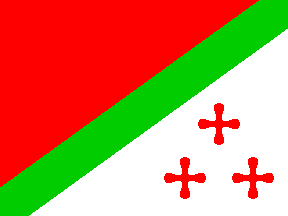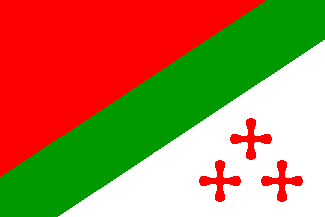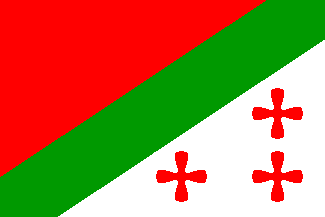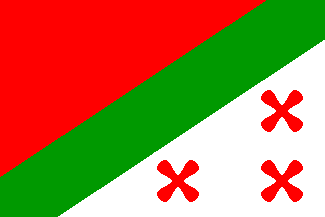
Last modified: 2006-01-14 by bruce berry
Keywords: shaba | katanga |
Links: FOTW homepage |
search |
disclaimer and copyright |
write us |
mirrors
 image
by Željko Heimer and António Martins, 25 Nov 2000
image
by Željko Heimer and António Martins, 25 Nov 2000
On 11 July 1960, with the connivance of Belgium and the support of Belgian
mining and commercial firms, Moise Tshombe, the Katanga leader, took advantage
of the breakdown of law and order in the newly independent Congo to declare
Katanga an independent state. Belgian troops were used to disarm and expel
Congolese army units from the territory although Belgium did not officially
recognise Katanga. Its main purpose was to insulate the province from the
disorder and militant nationalism sweeping the rest of the Congo and safeguard
Western investment there. The Congolese government under Patrice Lumumba
called for UN intervention and within a few days a UN force arrived in the
country. Belgian troops were eventually withdrawn from the Congo and
Lumumba insisted that UN troops be used to end the secession by Katanga, by
force if necessary. Despite continuing unrest in the remainder of the Congo,
efforts to resolve the Katanga "crisis" were unsuccessful until the failure of
diplomatic efforts led to a further build up of UN troops resulting in the
surrender of President Tshombe and his government on 15 January 1963, following
which Katanga passed into the control of the UN and central Congolese
government.
Bruce Berry, 27 January 2001
This flag is widely used today's by Katanga as a "Provincial" flag (Katanga
has an unofficial semi-autonomy status under Kabila's regime).
Jean-Luc Sohier, 19 February 2001
The flag was designed by my Godfather, Mr Louis Dressen.
He was born in Bielefeld (Germany) and moved to Liège (Belgium).
After a while in Zanzibar as manager of a Belgian bank
and settled
in Katanga in 1925. He was formerly the manager of Banque du Congo Belge
in Elisabethville. Althought a businessman (Les Bureaux Modernes, Carrières
de la Karavia, Plantations de Dilolo, ...) and architect, he designed many
city maps and the armorial bearings of Elisabethville ("ex imis ad culmina")
and of local schools (Institut Marie-José, Collège Saint
François de Sales). His wife (92) is still living in Liège
(Belgium). Louis Dressen died in Lubumbashi (formerly Elisabethville) in 1972.
Pierre Dressen, 20 Aug 2003
All four arms of the crosses are the same length; these crosses are
supposed to represent ingots and those were (crudely)
symmetrical. I have been researching Congo and Katanga for some time for
an upcoming book and during this research I’ve gone through numerous photos
and documents showing the flag or arms of Katanga, and I've also seen a
couple of preserved flags. Hence my knowledge on this subject.
Leif Hellström, 19 Apr 1999
The couped saltires are a kind of money. In central Africa, from
Congo to Zambia
and Zimbabwe, copper has been cast into cross-shaped bars for trade. Those
Katanga (or Baluba) crosses came up in various sizes, from a couple of
centimetres to nearly half a metre in diameter.
Harald Müller, 10 May 1996
The green stripe symbolises malachite (copper ore).
Werner Steurbaut, 24 February 2001
The saltires/crosses on the flag were called "croisettes" in Katanga.
Their heraldic use is prior to the State of Katanga as they were used in
the arms of the Katanga Province of the former Belgian Congo and the City of Elisabethville
(now Lubumbashi), the capital of Katanga.
The arms of Katanga Province were: "vert with three croisettes copper";
as far as I remember the croisettes were always represented as saltires
in this case.
The arms of Elisabethville and, with a slight modification, of Lubumbashi
today, were: "Silver with a gules chevron, accompanied by three gules croisettes"
(with, on the chevron, a silver crowned E letter for Elisabethville and
just L for Lubumbashi). In this case, the croisettes were always crosses.
I join an extract of the 1954 patent letter given to Elisabetville. Note
that in these letter the croisettes are described as "Katangese monetary
croisettes" ("croisettes monetaires katangaises") but not as saltires or
crosses; on the included drawing, they are designed as crosses.
Currently, the croisettes were red saltires on most part of the Katangese
flags. I remember to have seen sometimes croisettes as crosses on the flag,
but never they were copper. They were also in form of saltires for other
uses (by instance as rank marks for officers in Army or as marking on military
vehicles).
Jean-Luc Sohier, 19 February 2001
The motto of Katanga was "Power, Hope and Peace in Prosperity" ("Force,
espoir et Paix dans la Prosperite") and the components of the flag
represent it: Red for Power, Green for Hope, White for Peace and the croisettes
for Prosperity.
Jean-Luc Sohier, 19 Feb 2001
Based on a fresh look through my files I can provide the following info, based on the perhaps 15-20 illustrations of actual flags or representations of flags I found:
 image
by Željko Heimer, 26 Apr 1999
image
by Željko Heimer, 26 Apr 1999
As printed on a map of the capital Elisabethville. This has red crosses
with tapering arms of equal length and width, rounded ends upper cross
between the lower two.
Leif Hellström and Željko Heimer, 26 Apr 1999
 image
by Željko Heimer, 26 Apr 1999
image
by Željko Heimer, 26 Apr 1999
Note that the crosses have to be put vertically; on the first level,
one at the right side and on the second level, the right one under this
of the first level, and the other one at the left side.
J. Feuillat, 09 Jan 1999
 image
by Željko Heimer, 26 Apr 1999
image
by Željko Heimer, 26 Apr 1999
A flag used by a Katangese military unit has red saltires, with arms
of equal length and width and rounded ends. This image is one of the most
representative of how the flags looked in practice.
Leif Hellström, 26 Apr 1999
I collect banknotes and the last banknote of 10
Francs "produced" by the Republic of Katanga in 1962, but never used
(end of independence) has the national flag. The crosses are in the form
of saltires (x) and not as (+); IMO that form was on the official flag
of the republic
Marc Lasserre, 17 May 2002
We drew the flag in good faith from well researched and persuasive information.
I'm sure that we'll find out that the truth about the flag of Katanga is
more than having a site visitor saying: "That's wrong, this is the correct
one" every other year. Maybe there
were several, interchangeable designs? Maybe it changed over time?...
António Martins-Tuválkin, 19 May 2002
 image by Željko Heimer, 26 Apr 1999
image by Željko Heimer, 26 Apr 1999
This flag (with copper-colored, symmetrical saltires, placed first above
third) is listed under number 5 at the chart Flags of Aspirant Peoples
[asp] as: «Katanga [Shaba] (Independent
state, 1960-63) - Zaire.».
Ivan Sache, 12 Sep 1999
I think the Katanga crosses should be red, although one sometimes one
sees them in copper brown. The proportions are 2:3. [Not according to the
official regulation, but indeed used in most depictions.]
Harald Müller, 10 May 1996
 image
by Željko Heimer, 11 Jan 1999
image
by Željko Heimer, 11 Jan 1999
This image was made from a real Katanga flag from the Bruce Berry’s
collection. That flag clearly showed the crosses with one arm longer then
others.
Željko Heimer, 11 Jan and 26 Apr 1999
I found an image of a Katangese coin
of 5 francs showing this kind of cross.
Jarig Bakker, 31 Mar 1999
 image
by António Martins, 01 Dec 2000
image
by António Martins, 01 Dec 2000
This small flag [with hoist at the
right hand of the viewer — Ed.], shows yet another variation on the theme.
Leif Hellström, 30 Apr 1999
![[flag on stamp]](../images/c/cd_kat61.jpg) sent
by Željko Heimer, 26 Apr 1999
sent
by Željko Heimer, 26 Apr 1999
Katanga - Yvert Stamp catalogue ##66-68 depict the whole flag, anyone
collecting Katanga stamps?
Jarig Bakker, 25 Apr 2003
You asked about a copy of a stamp of the series 66/68 (Yvert et Tellier) -
here is the stamp #61, issued in 1961 with the image of President Tshombe.
B. Lagarrigue, 25 Apr 2003
![[Crosses on stamps #1]](../images/c/cd_kat1.jpg)
![[Crosses on stamps #2]](../images/c/cd_kat2.jpg) scanned by Mike Oettle, 02 Jan 2002
scanned by Mike Oettle, 02 Jan 2002
On checking my Katangese stamps, I find that the drawings of the croisettes
on the various flag images are fairly accurate. However, it might still
be helpful for you to have the two illustrations I've prepared of the two
stamp designs. For one thing, they confirm that the saltire conformation
was the one preferred by this short-lived state. Yvert Stamp-Catalogue
#57 and #54.
Mike Oettle, 02 Jan 2002